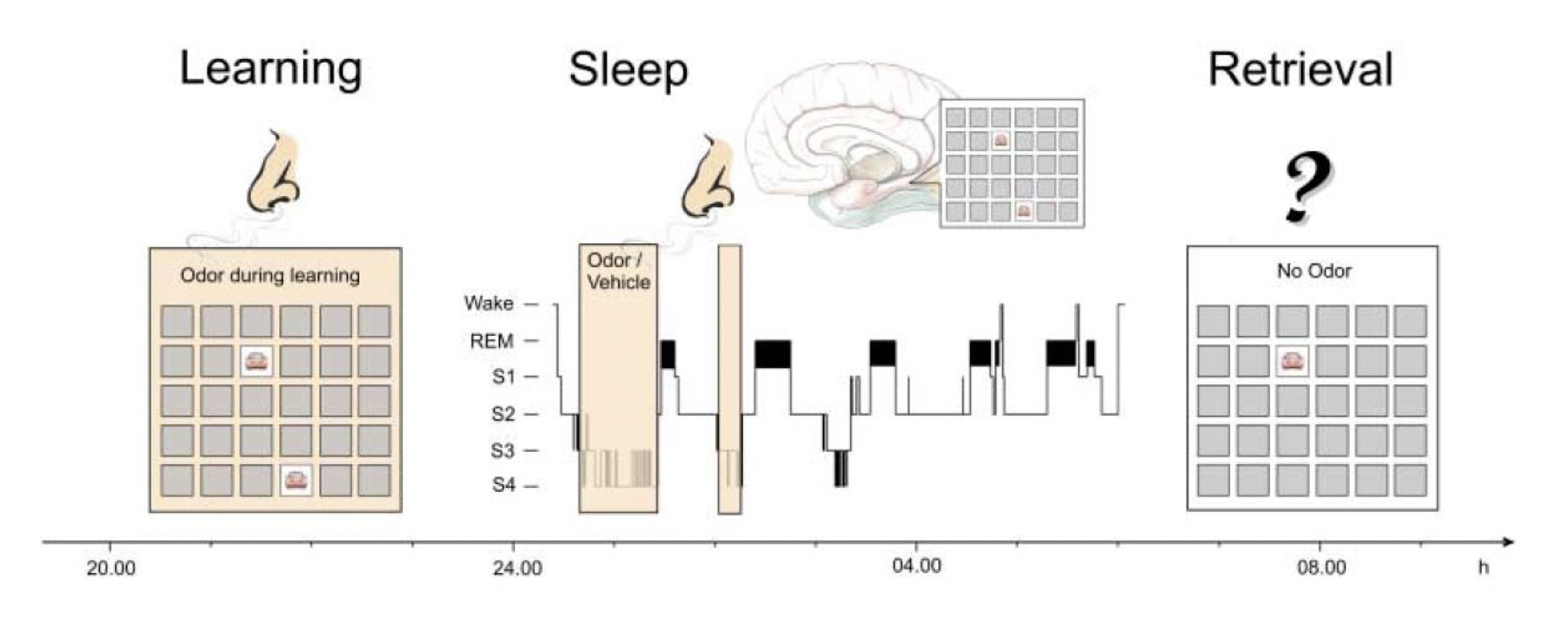lecture 2: synaptic plasticity and episodic memory
1/57
There's no tags or description
Looks like no tags are added yet.
Name | Mastery | Learn | Test | Matching | Spaced |
|---|
No study sessions yet.
58 Terms
what are the two main forms of synaptic plasticity?
short and long term synaptic plasticity
what is short term synaptic plasticity? and how long does it last for?
milliseconds to seconds
-change in probability of release due to recent activity
➢ More calcium ➔ More release
➢ Limited number of vesicles
➢ Inter-AP-time determines release
➢ Synapse ‘resets’ after ±1-5 second
-Short-term synaptic plasticity temporarily changes how likely a neuron is to release neurotransmitters, based on calcium buildup, vesicle availability, and the timing between action potentials. These changes fade after a few seconds as the synapse resets.
what is long term synaptic plasticity?
change in postsynapse and/ or presynapse
➢ Calcium is also involved
➢ Molecular mechanisms
➢ No reset! (Or very long time!)
what can you have in short term synaptic plasticity?
can have synaptic potentiation or depression
—> increase or decrease in amplitude of synaptic current
what is hebbian theory (long term synaptic plasticity)
memories are stored in the form of a network of neurons
-Simultaneous activation of a pre- and a postsynaptic neuron will
strengthen the synaptic connection between these cells.
what did Carla shatz say?
Those who fire together, wire together;
and those who fire out of sync, lose their link
-two different things represented together —> start to work together
how was long term habituation shown in work done by Eric Kandel on Aplysia Californica
-he flipped snail over
-the gill on the underside is very sensititive and crucial for survival
-if you touch the gill —> it will be withdrawn
-slowly overtime touching the syphon and gill —> synaptic depression and behavioral habituation
** cannot explain this with short term plasticity
what is habituation?
a decrease in response after repeated exposure to a stimulus
behavioural look of synaptical depression. A decrease in response after repeated exposure to a stimulus
what is sensitization?
An increase in response after repeated exposure to a stimulus or
combination of stimuli
how was long term sensitization shown in the aplysia California?
-tail shocks were given
-after 4 days there was an increased duration of withdrawal
What causes an increase in the probability of neurotransmitter release?
Residual calcium buildup in the presynaptic terminal.
How does calcium affect neurotransmitter release?
More calcium increases the likelihood of vesicle fusion and neurotransmitter release
Why can synaptic depression occur?
Because of a limited number of vesicles—if they're used up too quickly, the synapse weakens temporarily.
What neurotransmitter is involved in long-term synaptic plasticity?
Which two receptors does glutamate bind to?
Glutamate.
AMPA and NMDA receptors
What happens when AMPA receptors are activated?
They open and allow Na⁺ to enter the postsynaptic neuron, causing depolarization.
Why doesn’t NMDA receptor activation cause Ca²⁺ influx under normal conditions?
Because the NMDA channel is blocked by Mg²⁺ at resting membrane potential.
What is required to unblock the NMDA receptor?
Sufficient postsynaptic depolarization to expel the Mg²⁺ ion.
—> if you have Action potential magensium will pop out bc close to threshold (equilibrium potential)
What is the function of NMDA receptors in synaptic plasticity?
They act as coincidence detectors and allow Ca²⁺ influx only during strong stimulation, triggering long-term changes like LTP.
what does magnesium normally plug the NMDA receptors?
magnesium resting potential wants to go in, so thats why it plugs NMDA receptor
How is early-phase long-term potentiation (LTP) induced? (synapse specific)
Early-phase LTP is induced by delivering a high-frequency train of stimuli to the presynaptic neuron, which causes a large depolarization of the postsynaptic cell. This depolarization relieves the Mg²⁺ block in NMDA receptors, allowing Ca²⁺ to enter the postsynaptic neuron. The influx of calcium activates several intracellular signaling pathways, leading to a strengthening of the synapse.
what happens if early phase LTP happens a lot?
—> late phase LTP! second messengers travel back to the nucleus—> expression of proteins —> growth of new synapses
what changes occur on both the postsynaptic and presynaptic sides in the expression of early phase LTP?
Postsynaptic changes include the insertion of new AMPA receptors and phosphorylation of existing ones, increasing responsiveness to glutamate. Presynaptically, more glutamate is released. Together, these changes result in a larger EPSP when the presynaptic neuron fires.
what two phases make up long term synaptic plasticity?
early and late phase!
What is Long-Term Depression (LTD), and how does it occur?
LTD is a long-lasting weakening of synaptic strength. It often results from low-frequency stimulation or uncoordinated activity. A slow or small Ca²⁺ influx through NMDA receptors activates signaling pathways that lead to the removal of AMPA receptors from the postsynaptic membrane. This reduces the size of EPSPs. In some cases, less glutamate may also be released presynaptically.
what is early phase versus late phase?
Early phase:
• Relies on modifications of existing synaptic proteins
• Insertion of new AMPA receptors
• Phosphorylation of existing AMPA receptors → more efficient
• Retrograde signaling to presynapse → increased glutamate release
Late phase:
• Changes in gene expression leading to new protein synthesis
• growth of new synapses
Long-term Synaptic plasticity, Spike-timing dependent theory:
Spike-timing dependent plasticity (STDP) strengthens or weakens synapses based on the precise timing of neuronal spikes:
Presynaptic firing before postsynaptic firing → LTP
Postsynaptic firing not related to presynaptic activity → LTD
The further apart the spikes, the weaker the plasticity effect.
draw a tree of the different types of memory
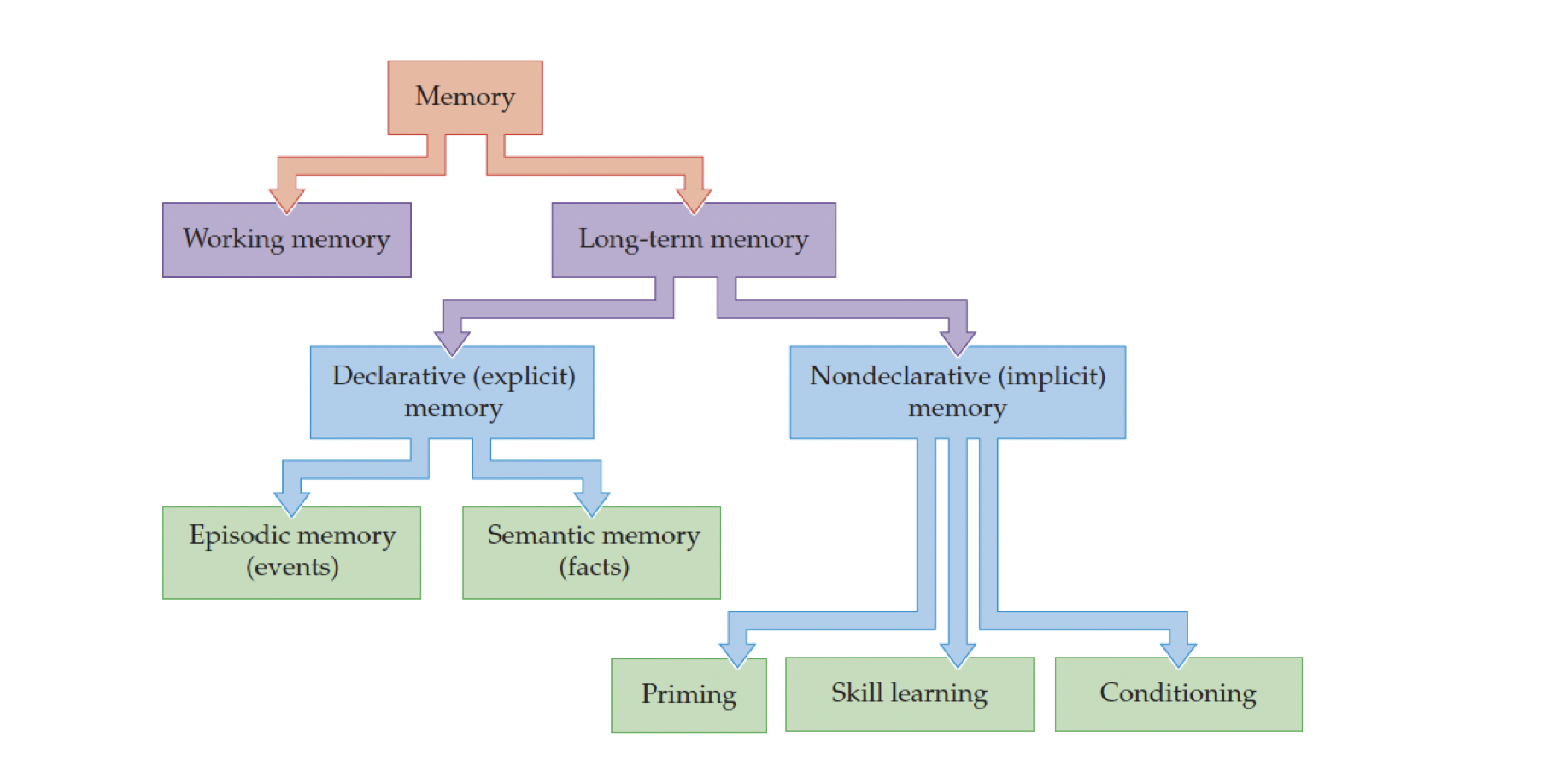
where does episodic memory reside in the brain?
neocortex!
what is Karl Lashley’s mass action principle?
Storage of memory is widely distributed across the cortex and not in in one specific locus of the brain
what did the study with rats in mazes and lesions show?
the more difficult mazes and also more cortical destruction —> more memory loss
Episodic Memory – Neural Substrates & Connections diagram

what is the role of the neocortex association areas?
» Processing perceptual information
» Long-term memory; distributed storage of
aspects of a memory
what is the role of the hippocampus in episodic memory?
Long-term episodic memory; stores events by
indexing the neocortical regions that were also
active during the event
patient H.M and Clive wearing both suffered from what? however what was still there?
anterograde and retrograde amnesia, remote memories were still there
What is the goal of the subsequent memory paradigm?
To identify brain activity during encoding that predicts whether an item will be remembered or forgotten later.
What happens during Phase 1 of the hippocampus imaging experiment?
Participants view a series of words inside an fMRI scanner to encode them while brain activity is recorded.
What happens during Phase 2 of the hippocampus imaging experiment? How is brain activity analyzed in the subsequent memory paradigm?
Participants take a recognition memory test outside the scanner, judging whether words were previously seen.
Researchers compare encoding-phase brain activity for remembered words vs. forgotten words.
What brain region shows greater activity for words that are later remembered? What does greater activity of this brain region during encoding suggest?
The medial temporal lobe, especially the hippocampus.
That the hippocampus plays a key role in successful episodic memory formation.
what are the different systems consolidations theories?
standard consolidation theory
multiple trace theory
relation memory theory
cognitive map theory
standard consolidation theory
As the memory consolidates, the connections between the different cortical modules are strengthened and the connection between the hippocampus and cortical modules are weakened.
-old memories independent of hippocampus, do not rely on hippocampus

context induced fear conditioning with mice, and how does it support standard consolidation theory?
survival strategy of mouse is to be still when afraid
-freezing behavior—> mouse has learned something
-in training give mouse a shock in a certain context
-in test see if the mouse in same context shows fear response
-remove hippocampus and can see if influence fear response on different days
-if you lesion day 1—> fear response gone
day 28—> no difference with control in terms of freezing
-Conclusion:
Hippocampus has a temporary role in the
storage and retrieval of a memory
But how does the hippocampus ‘know’ how to
reduce its influence (standard consolidation theory)
Once memory retrieval has become independent of hippocampus,
o Prefrontal cortex (PFC) may take over its integrative role
o PFC may also prevent the encoding of redundant information (e.g. information already stored) by inhibiting activity of the hippocampus.
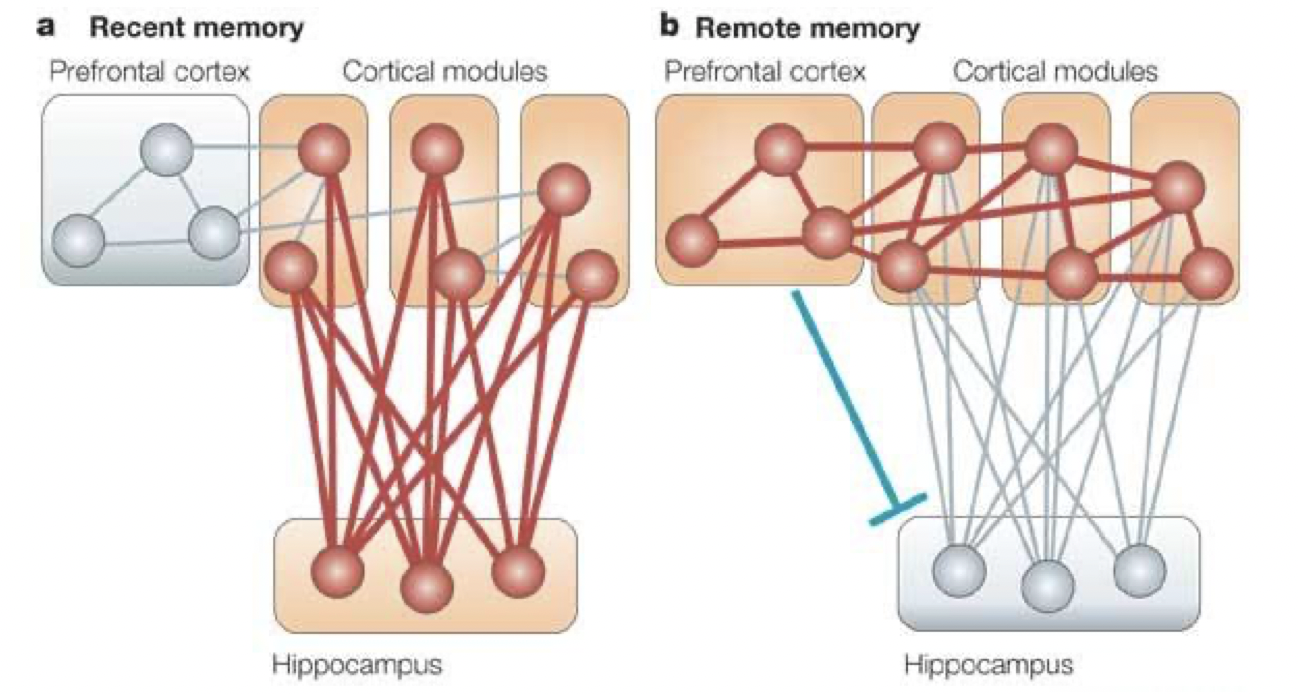
Prefrontal cortex (PFC) may take over the integrative role of the hippocampus – Experimental evidence..
Activity in prefrontal cortex increases for recall of remote
memories, compared with recent memories
• Activity decreases in CA1 (region in hippocampus)
• Disrupting prefrontal cortex selectively impairs remote recall
multiple trace theory
Every time a memory is reactivated, hippocampus is activated, and a new memory trace of the memory is stored in hippocampus
o Memory traces in cortex only are poor in resolution
o Memory traces between hippocampus and cortex are rich in details.
o So, retrieval can happen without hippocampus, but it will be less
detailed (Almost semantic, factual).
difference between standard consolidation theory and multiple trace theory?
-standard consolidation predicts no role of hippocampus for distant memories vs. multiple trace theory predicts continuous role for hippocampus to recall details
study done with amnesia and control personal and news details over time found what?
-details are lost by trauma to hippocampus
—> indicates that you can remember stuff but details are lost
(support multiple trace theory)
morris water maze set up
o Circular pool filled with milky water
o Surrounding environment contains visual cues
o A small platform is located just below the surface
o Animals need to learn the location of the platform
o Continual learning and thus shorter escape latency
over trials
control rat versus hippocampus lesioned rat in morris water maze results.. (lesion hippocampus and then train)
-rat with hippocampal lesion —> even with many trials cannot learn to/remember platform
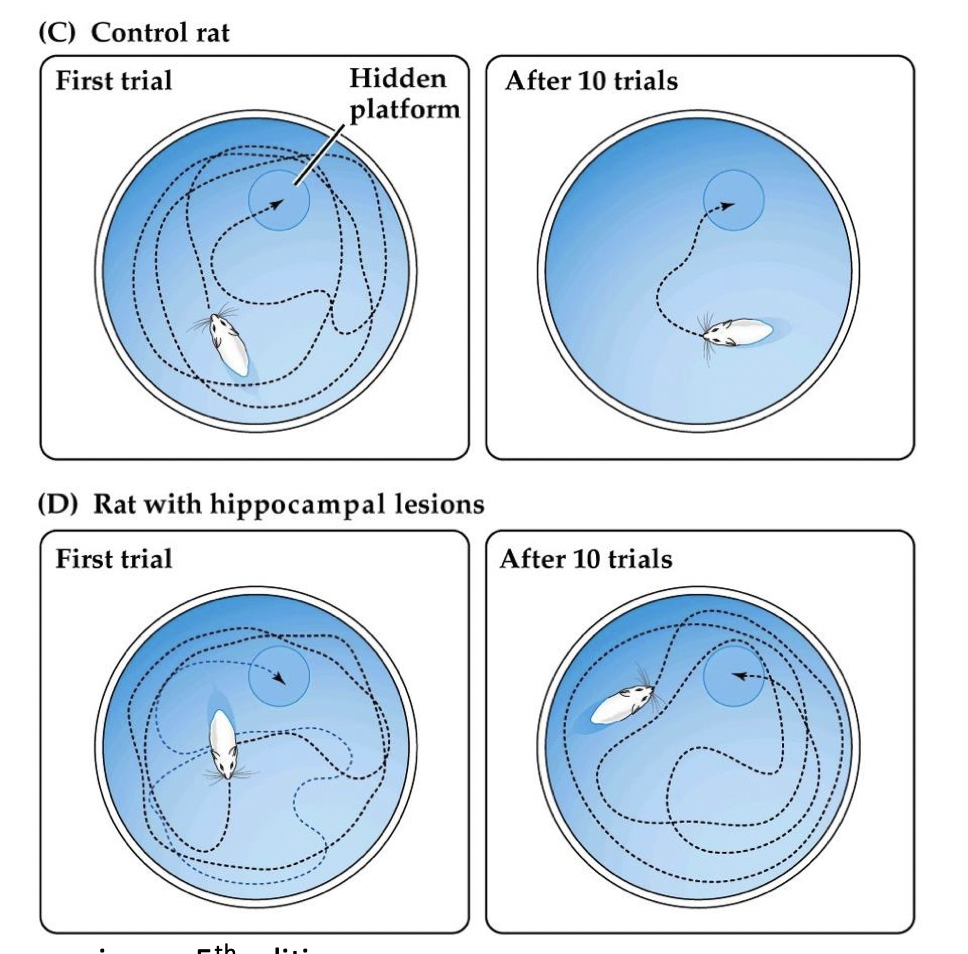
control rat versus hippocampus lesioned rat in morris water maze results.. (first train then lesion)? If and when do you expect a defect?
Sham-operated animals
• Intact memory
• Formation of new memory
Partial lesion
• Very little recall
• Impaired in learning
Complete lesion
• Flat memory
—> kind of supports standard consolidation theory
what test was done after the morris water maze with first train then lesion, and why was this done?
in order to test if results were bc role hippocampus plays in spatial processing or memory?
-variable versus constant start positions for the rat in the water maze
what do the variable versus constant start positions test? and what were the results?
variable start positions —> episodic
-if lesion to hippocampus, big impairment here
constant start position—> skill learning
-rely on procedural memory to find platform
-hippocampus not much involved here
( I always just go slightly to the right)
-red is hippocampal lesioned
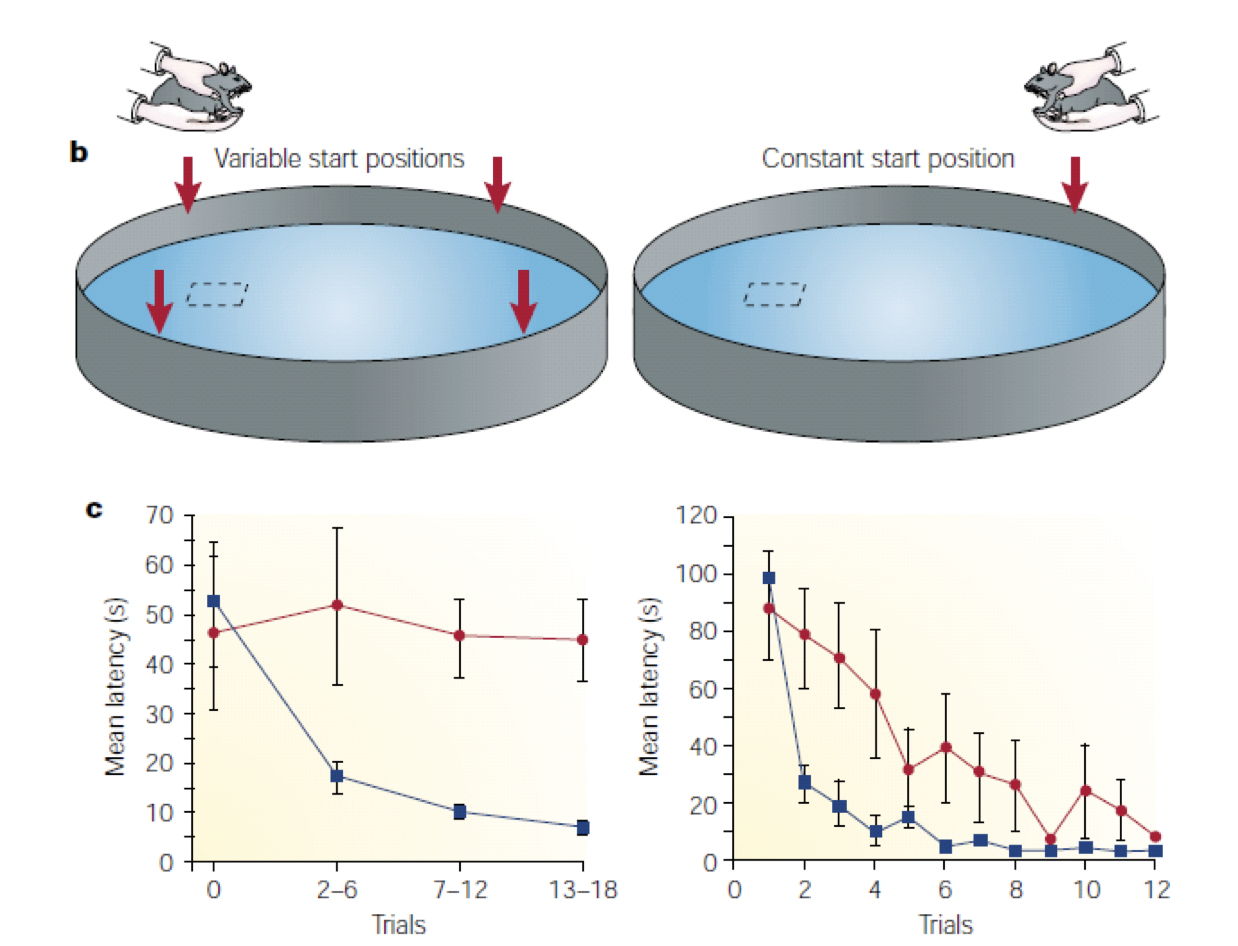
What type of memory is tested in the odor association task in rats? How is the odor association task structured?
Relational memory—the ability to learn and generalize the order or relationship between items (e.g., A > B > C > D > E).
Animals are trained on adjacent odor pairs (e.g., A vs. B, B vs. C), then tested on both adjacent and novel non-adjacent pairs (e.g., B vs. D) to assess generalization.
What happens when the hippocampus is damaged in the odor association task?
Animals can still perform adjacent comparisons but struggle with non-adjacent ones, showing impaired relational memory and generalization.
Why is the odor association task evidence for Relational Memory Theory?
Because it shows the hippocampus is needed not just for direct associations but also for inferring unseen relationships—supporting its role in relational memory.
** supportive of multiple trace theory
Cognitive map theory
Hippocampus contains a spatial map of the environment
Which famous study supports Cognitive Map Theory?
study on London taxi drivers, which found that their posterior hippocampus was larger than in controls.
suggesting adaptation to spatial memory demands.
sleep consolidates memory?
indicates a replay of task while sleeping—> moves memory from hippocampus to neocortex?

study of odor exposure and sleep results…
re-activation during Slow Wave Sleep seems to facilitate memory
consolidation
